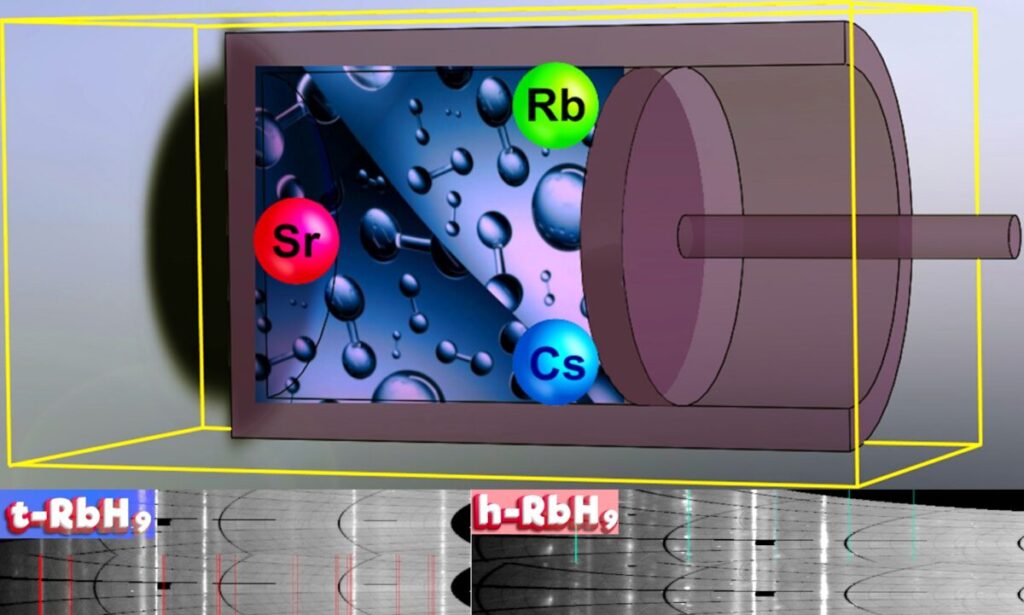A study led by Russia’s Skoltech and China’s HPSTAR suggests that rubidium and cesium additives could improve the efficiency of hydrogen batteries. Researcher Dmitrii Semenok explains pv magazine that “it is a matter of changing the approach to the search for promising hydrogen storage materials.”
Russian, Chinese, Japanese and Italian scientists have synthesized two polyhydrides – cesium heptahydride (CsH7) and rubidium nonahydride (RbH9) – for the chemical storage of hydrogen that can absorb ‘as much as four times’ hydrogen as often used magnesium-nickel and zirconium-vanadium alloys.
“Our work shows that cesium and rubidium have prospects to increase the capacity of hydrogen batteries by stabilizing the shell of molecular hydrogen, and opening a way to further reduce the synthesis pressure of polyhydrides,” the authors wrote in “Raisins in a hydrogen cake: ultra-stable cesium and rubidium polyhydrides“, published in Advanced energy materials.
Cesium (Cs) and rubidium (Rb) contain seven and nine hydrogen atoms per metal atom, respectively.
“The proportion of hydrogen atoms in these compounds is one of the highest of all known polyhydrides, twice as high as in methane CH4”, Dmitrii Semenok, corresponding author and researcher in China‘s Center for High Pressure Science and Advanced Research (HPSTAR), told pv magazine.
Semenok underlined that Сs and Rb are relatively heavy atoms. “For rubidium hydride RbH9, the mass content of hydrogen is approximately 9.6% by weight. This is also a very good result. The only problem is the need to apply pressure to synthesize these compounds,” the researcher said.
The researcher explains that cesium and rubidium and their hydrides pose two additional problems. Global production of Cs and Rb is significantly inferior to that of other alkali metals, and their costs are significantly higher than that of lithium, sodium or potassium.
At the same time, they are very active metals that easily catch fire in the air and react with water with explosion and formation of the strongest alkalis RbOH and CsOH.
The connections are therefore inconvenient for hydrogen storage, but the research is led by Russia‘Skoltech and China HPSTAR suggests that rubidium and cesium additives can improve the efficiency of existing H2 batteries.
“It’s about changing the approach to the search for promising hydrogen storage materials. We work under much higher pressure than previously accepted in this area. And we use elements that tend to form higher polyhydrides at low pressure,” says Semenok.
He added that systems such as Strontium-Rubidium Sr-Rb-H, Strontium-Rb-Zirconium-H, Rb-Magnesium-H may prove promising in terms of hydrogen storage and remain stable under ambient conditions after being saturated with hydrogen at high pressures of several GPa or even lower.
“The formation of higher cesium and rubidium hydrides at a relatively low pressure of about 10 GPa was predicted theoretically more than 10 years ago in the works of the group of E. Zurek (UB). The problem was only in the experimental validation of these results. Since the discovery of sulfur trihydride (H3S), the main attention of experimentalists has been focused on superconducting hydrides,” said Semenok, explaining why previous studies neglected the potential role of molecular polyhydrides based on cesium and rubidium.
Only recently has the situation changed due to the depletion of the class of binary superconducting hydrides. “The expansion of the research field to alkali and alkaline earth metals in 2021-2022 immediately led to the discovery of stable molecular polyhydrides of Cs, Rb, Ba and Sr, predicted in 2012-2015.”
In the paper, the researchers also proposed a new method for the synthesis of metal polyhydrides via high-pressure thermal decomposition of corresponding amidoboranes in diamond anvil cells.
“We now plan to repeat the experiment using large-scale hydraulic presses at a lower pressure – about 10,000 atmospheres – to obtain larger quantities of cesium and rubidium polyhydrides and verify that once synthesized, these compounds remain stable even at atmospheric pressure , unlike the others. hitherto known polyhydrides. From a fundamental point of view, this is an important task. We need to answer the question of how long metastable polyhydrides will persist under ambient conditions,” Semenok said, adding that they can exist within a very wide time frame – fractions of seconds or hundreds of days.
This content is copyrighted and may not be reused. If you would like to collaborate with us and reuse some of our content, please contact: editors@pv-magazine.com.

